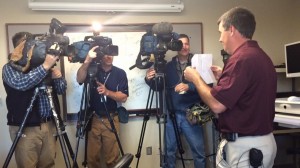By: Jarrod Mains
What do you know about product development? If you are like me when I decided to start a company that makes a new golf training aid, then nothing! I had zero experience designing, producing, building, managing, sourcing, or engineering a new product. The only thing I have ever done professionally is sell. But I was very passionate about this product my next door neighbor invented and I truly believe that it makes people who use it a better golfer. So we decided to start Perfect Shot Golf Loft, LLC.
I have learned the hard way that the most difficult part of developing a new product is getting the design and manufacturing set up. The initial steps you take during this process are crucial. I could not afford to make any mistakes as my budget was very limited, but like anything you haven’t done in life before, you live and you learn. I have listed several of the lessons I learned during my product development cycle over the past 18 months below with the hope that they can help you develop your own product quickly, efficiently, and as equally important: within your budget!
Lesson #1 – Do your research.
I’ve always liked the saying, “if you fail to plan, you are planning to fail.” I’ve never started a job I hadn’t researched and crunched numbers for prior to beginning and this venture was no different. Knowledge is power and the more knowledge you have, the better off you will be. Before starting a business you need to research the entire industry you are looking to enter and dissect any/all information available. Developing a business plan and researching how to make it happen is by far the most important step before you decide to start your own company.
Again, I had ZERO product development experience and really didn’t know what I was getting into but was so confident this product was going to be successful, that I didn’t care. I was focusing on what was going to happen several steps away, looking forward to the point where I had inventory to sell. Never in my wildest dreams did I think it would be so hard to get to that point! There is only so much you can do during the development stage as a sales/marketing guy. So like any smart CEO would do when he didn’t know what to do, I hired a consultant.
In August 2014, we sent our home built prototype to a company we contracted with in Buffalo, NY to look it over so they could build us a more professional, consumer ready product. They succeeded in doing this about eight months later. Which brings me to my next lesson…
Lesson #2 – Don’t contract with a design firm that is so far away.
The design stage of developing a product is critical. The more you can communicate and meet with your designers the better off you will be. Sam (my business partner) and I are in Florida; the consultants we hired were in Buffalo, NY. While we did do some Skype sessions and conference calls, it’s not the same as being able to drive down the street and check to see how your project is coming along.
Looking back, there were many small things these design consultants messed up which could have been avoided had we been closer to point things out sooner. Whenever somebody messes something up in the design stage, it not only costs time, but costs money too! Of course there will be some trial and error along the way, but the errors they made were pretty standard requests.
Sam was a foreman on large scale projects such as building power plants and skyscrapers, so he was very specific with how he wanted his invention built (our “blueprint”) yet these guys kept getting measurements wrong, spacing off, and all sorts of other things that seemed simple to us. We thought we were pretty clear as to what we were asking for and they always said they understood, but whenever we got a new part or sample piece the changes we asked for and things we stressed were not done properly until the second, third, fourth time.
For example, it was very frustrating having to tell professional design engineers to make sure the holes in the stakes are close enough together to where you have to squeeze the poles together providing more stability and friction on the unit, yet it takes them nine tries to get it right!
Lesson #3 – If possible, pay for the project as a whole, not on an hourly basis.
Design engineers are like lawyers. If you let them, they will rack up billable hours! We had the option upfront in this firm’s proposal to pay for the project as a whole, but we decided to go with the hourly option and have them send us monthly invoices for the time they spent working on our project. Maybe they were making all those mistakes referenced above on purpose to run up the bill on us, who knows. But we had to learn the expensive way that it would have been much better to pay one lump sum for the project instead of leaving it open to the engineers to “work” on it at their own discretion will while working on other projects for their other clients simultaneously.
This company itemized their hours so I was able to see how much time they claimed they were working on each portion of the product. After looking at the monthly invoices each month, I was getting fed up of seeing some of the same stuff on there each and every month for things that should have been completed already. Again, being so far away and never meeting these guys in person was a big mistake. The trust factor was lacking.
Lesson #4 – Search for vendors yourself.
Again, I had to learn this the hard/expensive way! The consultants we hired claimed they already had resources in place to get us all the parts we needed in their initial proposal. We soon figured out that was far from reality as they were simply searching online for vendors and charging us to do it. After a few months I finally asked them why it was costing us so much for them to search for vendors and why it was taking so long to find these resources they claimed they already had in place. After that conversation, I decided to take over this aspect of the process myself.
If you don’t search for your own vendors – which isn’t hard, just time consuming – you pay engineers $90+ per hour to do it for you! The consultants initially got us three quotes on injection molds, all of which were over $100,000. I made the mistake of simply sending them websites saying, “Hey look into these guys,” not knowing they were still going to charge me so much money to gather these quotes.
I finally told them to stop searching for vendors, I’ll do that from now on. And boy was that a great decision! I not only saved money by searching myself, I saved money by finding better priced vendors for virtually every part we needed! Plus, I learned a lot about manufacturing while doing my searches and talking to these vendors so this move was quite beneficial.
Lesson #5– Plan for your product to take longer than expected.
Our objective when we first started was to have a finished product in time for the start of golf season, spring of 2015. That didn’t happen. Designing and ordering custom parts that don’t exist yet takes longer than you probably think. For one, it was tough to find vendors in the USA to do it at a reasonable cost, so lots of times we had to get sample parts from China…which means waiting for them to get here. If you don’t want to spend the extra money on shipping overnight internationally – which can add up quick – you have to wait longer. But time is money so you have to consider what is best for your situation.
Around June of 2015, the product was finally designed the way we wanted it and we had found vendors for most of the parts. Now we were finally ready to go to production! Except there was one more problem…we didn’t have enough money to pay for the injection molds. All of our start-up funds went into product development and legal fees (patents, trademarks, operating agreements, etc.). While we could make our product cheaper and “dumb it down” a little bit, we don’t want to do that.
We want this to be the Cadillac of golf training aids instead of being like most of the other cheap crap out there on the market. We want people to use this product for years, not just once or twice and throw it away like a lot of other goofy golf gadgets. I’m smart enough to know that cheap doesn’t last and you get what you pay for, I’m a big believer in that. If we start cutting corners now and cheapening our product, it’s going to cause us more work and cost us more money in the long run. And we can’t afford that. So we decided to build it the right way rather than the quick and cheap way.
I hope these lessons and our company’s start-up experience have helped you understand the product development stage in some way. While it does require hard work, I want to encourage you to go for it, just be mindful of what it takes to be successful. We have passed a big road block but the route has only begun as we have many more obstacles to navigate through. Stay tuned for my next article on fundraising and creating a crowd funding campaign. Until then, to be continued… 
—–
Jarrod Mains is the CEO of Perfect Shot Golf Loft, LLC. He has many years of experience working in the professional sports industry with a variety of leagues and in a variety of roles. He earned his MBA in Sports Management from Florida Atlantic University. He can be reached here.





